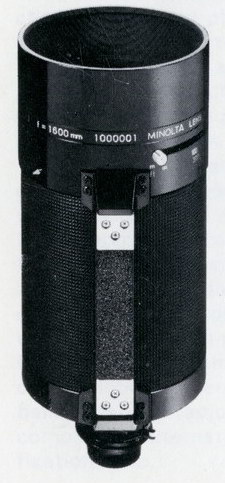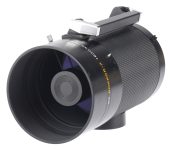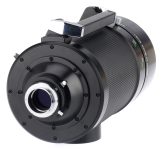Minolta RF Rokkor 1600mm F/11
Super telephoto prime lens • Film era • Discontinued
- Announced:
- · March 1974
- Production status:
- ● Discontinued
- Country of design:
- · Japan
- Original name:
- · MINOLTA RF ROKKOR 1:11 f=1600mm
- · MINOLTA RF ROKKOR 1600mm 1:11
- Class:
- · Ultra-slow full-frame super telephoto prime lens
- · Mirror/Reflex lens
- System:
- · Minolta SR (1958)
Model history (2)
| ■Minolta RF Rokkor 1600mm F/11 | -- | 6 - 5 | 20.00m | -- | 1974 ● | |
| ■Minolta RF 1600mm F/11 | -- | 6 - 5 | 20.00m | -- | 1981 ● | |
Specification
| Optical design: | |
| 35mm full frame | |
| 1600mm | |
| F/11 | |
| 6 elements in 5 groups | |
| Minolta SR [43.5mm] | |
| 1.5° (35mm full frame) | |
| Diaphragm mechanism: | |
Diaphragm type: | Fixed |
Aperture control: | None |
| Focusing: | |
| 20m | |
| <No data> | |
Focusing modes: | Manual focus only |
Manual focus control: | Focusing lever |
| Physical characteristics: | |
| 6700g | |
| ⌀178×322.5mm | |
| Accessories: | |
| Removable front filters are not accepted | |
| Rear screw-type 39mm | |
| Screw-type round | |
| Minolta 2X Tele Converter 200-L → 3200mm F/22 | |
| Minolta MD 2X Tele Converter 300-L → 3200mm F/22 |
Sources of data
- A guide to the Minolta SLR system of creative photography 605E-I1.
- Minolta lenses: vision for the creative photographer booklet.
- Minolta Corporation Photographic Division 1981/1982 Catalog (March 1981).
- Minolta SRT cameras and systems.
- A guide to the Minolta SLR system of creative photography 603E-H1.
- A guide to the Minolta SLR system of creative photography 803E-M1.
Manufacturer description #1
Minolta's most powerful telephoto provides phenomenal "reach": 32 times greater than a normal lens. Yet it is only slightly over a foot long because of its catadioptric design. Incorporating special optical mirrors in combination with conventional refractive lens elements, this super-telephoto lens provides superior image quality as well as compact design.
Manufacturer description #2
The catadioptric-type 800mm and 1600mm RF Rokkor-X's, utilize precision ground-and-polished mirrors in combination with conventional refractive lens elements in their designs. Light travels the length of the barrel three times in an overlapping reflex path, resulting in relatively small bulk for such enormous focal lengths.
This compactness is particularly striking in the 800mm RF Rokkor-X, which yields some 16 times the magnification of a standard lens yet can even be used hand-held - rare with optics of this great focal length. Similarly, the actual length of the 1600mm RF Rokkor-X measures only one fifth of its extraordinary focal length, which produces images 32 times larger than a standard lens.
Both of these mirror lenses are suited for sports, landscape, and nature photography at extreme distances. Lens-stop settings for them are achieved with neutral-density filters, which, like the special "sharp-cut" filters provided consitute integral elements of the optical system.
Manufacturer description #3
A different kind of telephoto lens is the catadioptric design, that folds the light path via high-quality-optical mirrors in combination with conventional refractive lens elements. Minolta makes four of these - the 250mm F/5.6 RF, 500mm F/8 RF, 800mm F/8 RF and 1600mm F/11 RF - and each is outstanding in terms of fantastic reach and a surprisingly lightweight design. These super telephoto lenses are indispensable for sports, nature and landscape photography. The 250mm F/5.6 RF is the world's first reflex-type medium telephoto lens, a beauty to handle. The 500mm F/8 RF is one of the smallest, lightest of its focal length available to the photographers today, and makes long-telephoto photography a hand-held situation. This superb Minolta lens weighs only 600g and is hardly larger than a conventional medium telephoto lens. The 800mm F/8 RF also features a compact size for such a long focal length, which contributes to convenient handling portability. The 1600mm F/11 RF is the longest Minolta lens of all, providing phenomenal telephoto capabilities. All of the mirror-type lenses have built-in filters that are rear-mounted for additional versatility. With the use of the built-in ND (Neutral Density) filter, for instance, the amount of light passing through each lens may be reduced.
Manufacturer description #4
This is the longest Rokkor-X providing phenomenal telephoto capabilities. Like the 800mm lens, this Rokkor-X is the catadioptric design, incorporating special optical mirrors in combination with conventional retractive lens elements. Light travels through the lens three times, resulting in a folded optical path. Focusing is achieved by moving a mirror element; light control is via a neutral-density filter. The 1600mm also has UV, yellow, orange, and red integral-element type filters. This lens, which is only slightly longer than 322.5mm (one foot), is fitted with tripod sockets for mid section support and protection against vibration.
Typical characteristics of mirror (reflex) lenses
- Catadioptric system consisting of curved mirrors and optical glass;
- Much shorter, lighter and less expensive designs than conventional super telephoto lenses;
- Outstanding correction of chromatic aberrations;
- Since the aperture is fixed, neutral density filters are used to obtain a smaller aperture;
- Doughnut-shaped out-of-focus highlights.
From the editor
The lens was supplied with L39 (UV), Y48, O56 and R60 rear 39mm screw-type filters. Drop-in slot was used for ND4x filter which was also a part of the package.
In 1978, Y48 was replaced by Y52, and in 1980, L39 (UV) was replaced by the NORMAL filter.
Other super telephoto prime lenses in the Minolta SR system
| ■Minolta SR mount (5) | |||||||||
| Minolta RF Rokkor 500mm F/8 | -- | 6 - 5 | 4.00m | ⌀77 | 1977 ● | ||||
| Minolta RF Rokkor 800mm F/8 | -- | 8 - 7 | 8.00m | -- | 1973 ● | ||||
| Minolta RF 800mm F/8 | -- | 8 - 7 | 8.00m | -- | 1981 ● | ||||
| Minolta RF Rokkor 1000mm F/6.3 | -- | 7 - 6 | 30.00m | -- | 1965 ● | ||||
| Minolta RF 1600mm F/11 | -- | 6 - 5 | 20.00m | -- | 1981 ● | ||||








